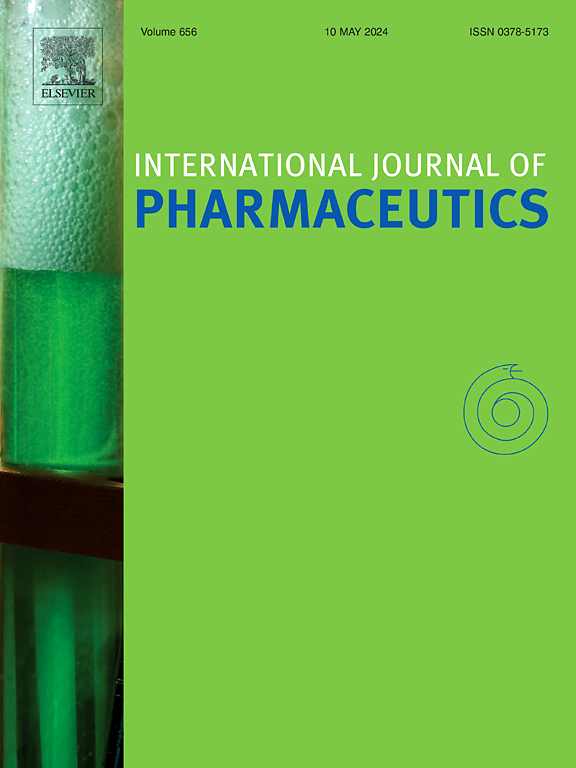Pulmonary delivery of LNP-mRNAs aerosolised by vibrating mesh nebulizer: An emphasis on variations and in-depth analyses of physicochemical properties
IF 5.2
2区 医学
Q1 PHARMACOLOGY & PHARMACY
引用次数: 0
Abstract
The delivery of lipid nanoparticle (LNP)-mRNAs to the lungs attracts fast increasing interests for vaccination, as the mucosal immunity in the airway can prevent the establishment of an infection rather than only reduce the level of infection associated with systemic immunity triggered via intramuscular injection. The vibrating mesh nebuliser was well utilized to atomize inhalation solutions/suspensions for pulmonary delivery hence employed in this study for aerosolising LNP-mRNAs. In comparison with pre-aerosolised LNP-mRNAs, the post-aerosolised vectors demonstrated a significant increase (t-test, unpaired, p < 0.05) in particle size (215–363 nm vs. 116–130 nm), polydispersity index (PDI: > 0.33 vs. < 0.27), zeta potential (ZP: 11–14 mV vs. 2.6–7.7 mV), and encapsulation efficiency (EE: ∼99 % w/w vs. ∼91 % w/w), indicating a structural alteration upon high-frequency mesh vibration (HFMV). The particle sizes of LNP-mRNAs were further enlarged upon inertial impaction, and the size increments were dependent on the velocities of airflow for impaction and the N/P ratios. The aerosolised mists were fine, with >54 % w/w deposited in lower respiratory tract and >28.5 % w/w further delivered to alveolar regions. Further, a model was created to elucidate the variations of physicochemical properties for LNP-mRNAs upon HFMV and inertial impaction, and it disclosed that the fluidity and shear-induced fusion of LNPs were the fundamental reasons to cause these unfavourable changes particularly the size enlargement. These insights reveal that the effective development of inhaled LNP-mRNAs will rely on shear-less devices, formulation optimizations, inhalable dry powders, and their potential combinations.

通过振动网状喷雾器雾化lnp - mrna的肺递送:强调变化和物理化学性质的深入分析
脂质纳米颗粒(LNP)- mrna递送到肺部吸引了越来越多的疫苗接种兴趣,因为气道粘膜免疫可以防止感染的建立,而不仅仅是降低与肌肉注射引发的全身免疫相关的感染水平。振动网状喷雾器很好地用于雾化吸入溶液/悬浮液用于肺输送,因此在本研究中用于雾化lnp - mrna。与雾化前的lnp - mrna相比,雾化后的载体显示出显著增加(t检验,未配对,p <;0.05),多分散性指数(PDI: >;0.33 vs. <;0.27), zeta电位(ZP: 11-14 mV vs. 2.6-7.7 mV)和封装效率(EE: ~ 99% w/w vs. ~ 91% w/w),表明高频网格振动(HFMV)导致结构改变。惯性撞击后lnp - mrna的粒径进一步增大,且粒径增量与撞击气流速度和N/P比有关。雾化雾很好,54% w/w沉积在下呼吸道,28.5% w/w进一步传递到肺泡区。此外,我们建立了一个模型来阐明lnp - mrna在HFMV和惯性冲击下的物理化学性质变化,揭示了lnp的流动性和剪切诱导融合是导致这些不利变化特别是尺寸增大的根本原因。这些见解表明,吸入lnp - mrna的有效开发将依赖于无剪切设备、配方优化、可吸入干粉及其潜在组合。
本文章由计算机程序翻译,如有差异,请以英文原文为准。
求助全文
约1分钟内获得全文
求助全文
来源期刊
CiteScore
10.70
自引率
8.60%
发文量
951
审稿时长
72 days
期刊介绍:
The International Journal of Pharmaceutics is the third most cited journal in the "Pharmacy & Pharmacology" category out of 366 journals, being the true home for pharmaceutical scientists concerned with the physical, chemical and biological properties of devices and delivery systems for drugs, vaccines and biologicals, including their design, manufacture and evaluation. This includes evaluation of the properties of drugs, excipients such as surfactants and polymers and novel materials. The journal has special sections on pharmaceutical nanotechnology and personalized medicines, and publishes research papers, reviews, commentaries and letters to the editor as well as special issues.

 求助内容:
求助内容: 应助结果提醒方式:
应助结果提醒方式:


